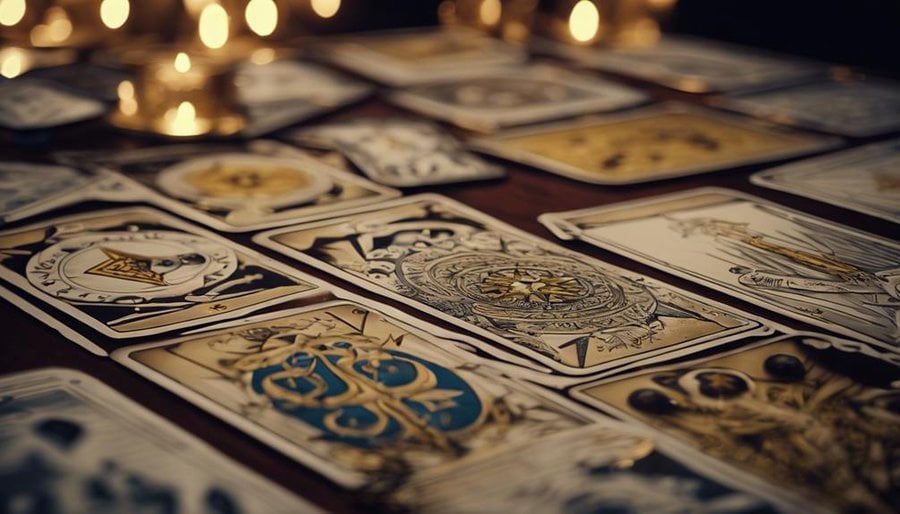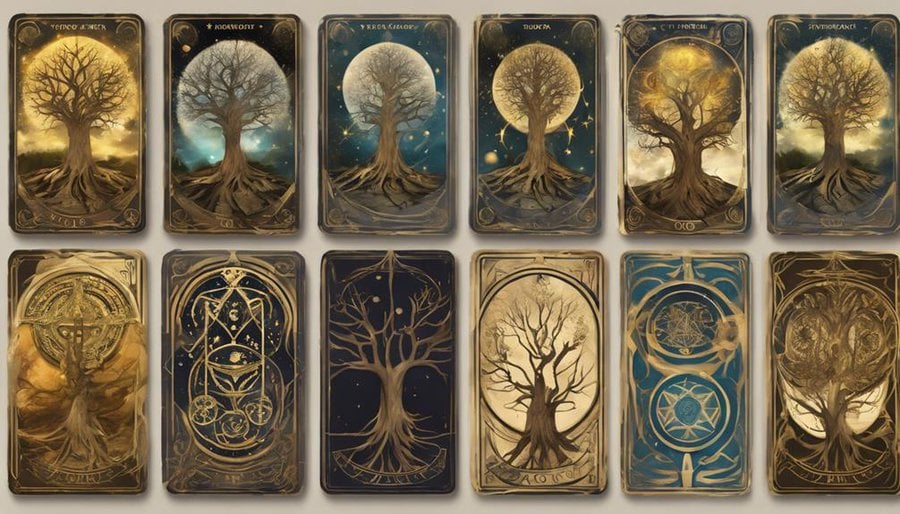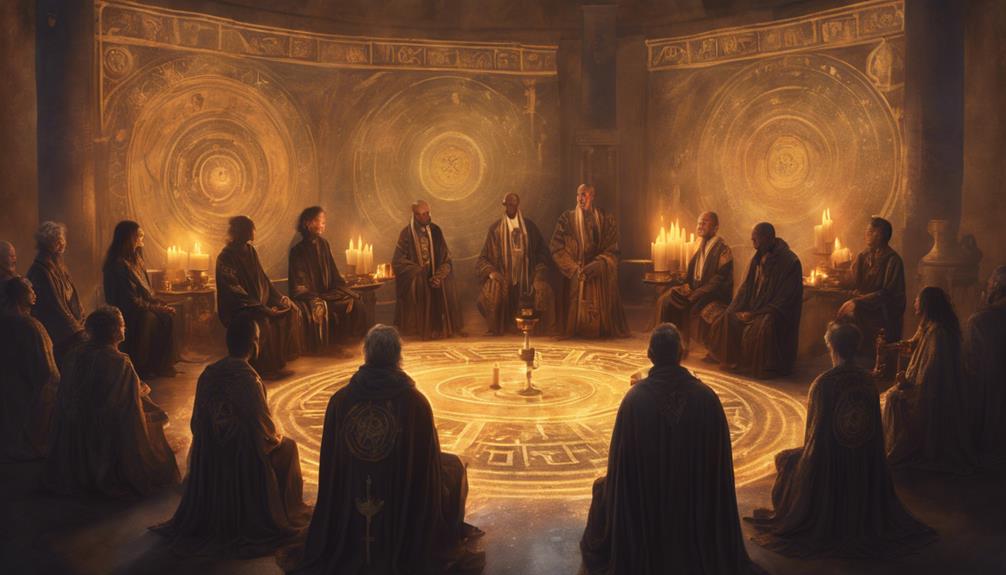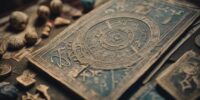How the Golden Dawn Society Influenced Modern Tarot Practices

The Golden Dawn Society's Influence on Modern Tarot Practices:
Unveiling esoteric wisdom and mysticism, their teachings transformed Tarot into a powerful tool for self-discovery through symbolism and rituals.
Their impact continues to shape how Tarot is used today, leaving a timeless legacy for practitioners.
Origins of the Golden Dawn Society
How did the Golden Dawn Society come into existence and shape the world of modern tarot practices? The Golden Dawn's origins trace back to the late 19th century in England. Founded by three Freemasons, William Robert Woodman, William Wynn Westcott, and Samuel Liddell Mathers, this esoteric order explored the mystical arts, alchemy, and the Kabbalah. Influenced by the Rosicrucian and Freemason traditions, the society aimed to provide its members with a structured system of spiritual development and enlightenment.
Drawing from various occult sources, the Golden Dawn incorporated rituals, symbolism, and teachings to create a structured framework for its members to explore the depths of the esoteric world. The society's emphasis on personal growth, ritual magic, and symbolic interpretation greatly influenced the modern tarot practices we see today.
Through their secret society influences and dedication to esoteric knowledge, the Golden Dawn Society laid the foundation for the integration of tarot into spiritual practices, paving the way for a deeper understanding of the cards' meanings and symbolism.
Incorporation of Tarot Into Teachings
Indefinitely, practitioners of the Golden Dawn Society integrated tarot into their teachings as a powerful tool for spiritual exploration and symbolic interpretation. The incorporation of tarot into their practices wasn't merely about fortune-telling but a way to immerse deeper into the mysteries of the universe. Here are three ways in which tarot was integrated into their teachings:
- Symbolism: The Golden Dawn Society emphasized the rich symbolism present in each tarot card, teaching their members to see beyond the surface and uncover the hidden meanings within the intricate imagery.
- Practical Application: Tarot wasn't just studied theoretically but was actively used in rituals and meditations to enhance spiritual growth and self-awareness among members.
- Divination Practices: While divination was part of the tarot practices within the society, it was viewed as a tool for self-reflection and gaining insights rather than a means to predict the future with certainty.
Development of Tarot Symbolism

Tarot symbolism underwent a profound evolution within the Golden Dawn Society, becoming intricately woven into their spiritual teachings and practices. The development of tarot symbolism during this time was marked by a deep exploration of esoteric meanings and connections to various mystical traditions. The members of the Golden Dawn probed into the symbolism present in each card, seeking to reveal its hidden significance and incorporate it into their rituals and meditations.
| Evolution of Tarot Symbolism | Interpretation |
|---|---|
| Uncovering hidden meanings | Investigating mystical connections |
| Exploring esoteric depths | Incorporating symbolism into rituals |
| Connecting with traditions | Seeking spiritual enlightenment |
| Infusing with mystical energy | Enhancing divinatory practices |
| Symbolism as spiritual guide | Deepening understanding of the self |
This exploration of tarot symbolism not only enriched their spiritual practices but also laid the foundation for modern tarot interpretation, influencing how we view and understand the cards today.
Impact on Tarot Interpretation
As the Golden Dawn Society explored the intricate world of Tarot, their influence left an indelible mark on the way these mystical cards are interpreted today.
Through a lens of symbolism deeply rooted in esoteric traditions, the Golden Dawn's impact on Tarot interpretation can be seen in the intricate layers of meaning attributed to each card.
Their innovative interpretive techniques continue to shape how Tarot readers reveal the secrets hidden within the cards, guiding seekers on their spiritual journeys.
Symbolism in Tarot
Symbolism within the Tarot cards intricately weaves a tapestry of meaning that significantly influences how readers interpret the messages conveyed through the imagery.
- Multilayered Meanings: Each card in the Tarot deck is rich in esoteric symbols and hidden meanings, allowing for interpretations that go beyond the surface level.
- Personal Connection: The symbolism in Tarot cards often resonates differently with each individual, encouraging a personal exploration of the hidden messages within the imagery.
- Guidance and Insight: By delving into the symbolism present in Tarot cards, readers can gain profound insights and guidance that can aid them in maneuvering life's complexities with a sense of freedom and empowerment.
Esoteric Influences
With a history deeply intertwined with mystical teachings and arcane practices, the esoteric influences on Tarot interpretation have shaped the way readers engage with the cards' enigmatic messages.
The Golden Dawn Society, known for its exploration of occult practices, introduced a new layer of depth to Tarot readings by incorporating esoteric symbolism and metaphysical concepts into the interpretation of the cards. This infusion of esoteric influences added a spiritual and mystical dimension to Tarot readings, allowing readers to explore into the subconscious worlds and connect with higher spiritual truths.
Interpretive Techniques
The integration of interpretive techniques in Tarot readings has greatly influenced the depth and understanding readers bring to the enigmatic messages conveyed through the cards. Over time, these techniques have evolved, drawing from the rich historical context of Tarot's journey through different cultures and belief systems.
Here are three key ways interpretive techniques have impacted modern Tarot interpretation:
- Symbolic Analysis: Readers explore into the symbolic meanings behind each card, interpreting how these symbols relate to the querent's situation.
- Intuitive Exploration: Encouraging readers to tap into their intuition, interpretive techniques prompt a deeper connection with the cards and their meanings.
- Storytelling Approach: By weaving narratives based on the cards' imagery, readers construct cohesive and insightful readings that resonate with the querent's circumstances.
Influence on Tarot Spreads
During the resurgence of interest in Tarot during the late 19th and early 20th centuries, the Golden Dawn Society played a pivotal role in shaping the structure and complexity of Tarot spreads used in modern practices. The Society's focus on esoteric knowledge and symbolism heavily influenced the development of intricate spread variations that are widely used today. These spreads go beyond simple past-present-future layouts, delving into relationships, personal growth, and spiritual insights.
To illustrate some of the spread variations influenced by the Golden Dawn Society, consider the table below:
| Tarot Spread | Description |
|---|---|
| Celtic Cross | One of the most popular spreads, offering insight into various aspects of the querent's life. |
| Tree of Life | Based on the Kabbalistic Tree of Life, providing a deeper understanding of spiritual paths. |
| Astrological Spread | Aligns Tarot cards with astrological houses for guidance on how celestial energies influence the situation. |
These intricate spreads not only offer a rich tapestry of meanings but also encourage seekers to explore the depths of their subconscious and connect with the divine energies surrounding them.
Legacy of Golden Dawn Rituals

In the domain of modern Tarot practices, the enduring legacy of Golden Dawn rituals continues to shape the spiritual journeys of practitioners worldwide. The rituals established by the Golden Dawn Society have left an indelible mark on the way Tarot is approached and utilized in contemporary settings. Here are three key aspects of the legacy influence and modern practices stemming from the Golden Dawn rituals:
- Symbolism and Correspondences: The Golden Dawn rituals emphasized the importance of symbolic meanings and correspondences in Tarot cards. This focus on rich symbolism has endured and is integral to how modern practitioners interpret and derive insights from the cards.
- Ritualistic Practices: The structured and ceremonial approach to Tarot readings that originated from Golden Dawn rituals still influences modern practices. Many practitioners incorporate ritualistic elements into their readings to enhance the spiritual experience.
- Spiritual Development: Golden Dawn rituals placed a strong emphasis on personal growth and spiritual development through Tarot. This legacy continues to inspire practitioners to use Tarot not just for divination but also as a tool for inner exploration and self-discovery.
Integration of Esoteric Correspondences
As modern Tarot practices evolved, the integration of esoteric correspondences became a fundamental aspect. Symbolism in Tarot, the interplay of numerology, and the incorporation of astrology all form a rich tapestry within Tarot readings.
These elements not only add layers of meaning to the cards but also deepen the spiritual connection between the reader and the deck.
Symbolism in Tarot
Interwoven with mystique and ancient wisdom, the tarot deck intricately weaves together esoteric correspondences, symbolizing a rich tapestry of meanings that resonate through modern tarot practices.
Within the cards lie hidden meanings and esoteric symbolism waiting to be deciphered by those who seek to explore the depths of their subconscious and the universe.
Each symbol, from the intricate patterns on the Fool's clothing to the mystical creatures in the Moon card, carries layers of significance that connect the personal with the universal.
The fusion of astrology, alchemy, and Kabbalah within the tarot imagery creates a harmonious blend of esoteric knowledge, offering seekers a pathway to self-discovery and spiritual enlightenment.
Numerology and Tarot
Exploring the intricate web of esoteric correspondences within tarot, numerology emerges as a key facet enriching the tapestry of symbolism and meaning woven into each card. Numerology basics offer a framework for understanding the deeper significance of tarot cards. By assigning numerical values to the cards and investigating their connections to universal energies, practitioners can dive into profound interpretations. Below is a table illustrating the numerology basics and their tarot connections:
| Numerology Basics | Tarot Connections |
|---|---|
| Number 1: New beginnings, leadership | The Magician: Manifestation, creativity |
| Number 7: Spirituality, introspection | The Chariot: Willpower, determination |
| Number 10: Completion, fulfillment | The Wheel of Fortune: Change, destiny |
| Number 22: Master builder, vision | The Fool: Infinite possibilities, new journeys |
Astrology in Tarot
Utilizing astrological correspondences, the integration of celestial influences in tarot adds a layer of depth and insight to readings, enhancing the interconnected tapestry of esoteric wisdom. Astrology influences the interpretation of tarot cards by assigning each card a zodiac sign, planet, or element, allowing for a richer understanding of the cards' meanings.
This connection between astrology and tarot creates a bridge between the cosmic forces at play in the universe and the personal journey reflected in a tarot reading. By incorporating astrological correspondences, tarot readers can explore deeper into the subconscious worlds and provide more nuanced interpretations for seekers, guiding them towards self-discovery and empowerment.
- Assigning zodiac signs to tarot cards.
- Linking tarot cards to planetary influences.
- Connecting tarot cards with elemental associations.
Modern Tarot Practices and Golden Dawn
In the domain of modern tarot practices, the influence of the Golden Dawn Society is unmistakable, shaping the way many contemporary practitioners approach the interpretation and symbolism of tarot cards. The Golden Dawn's impact on modern tarot practices can be seen in the evolution of how tarot decks are structured and understood. The Society's emphasis on symbolism, esoteric knowledge, and the interconnectedness of various mystical traditions has deeply influenced the way tarot is used today.
Practitioners who draw inspiration from the Golden Dawn often incorporate elements of Kabbalah, astrology, alchemy, and numerology into their tarot readings. This multidimensional approach adds layers of meaning to the cards, allowing for more nuanced and insightful interpretations. The Golden Dawn's legacy has encouraged modern tarot enthusiasts to explore the depths of each card, uncovering hidden truths and deeper connections in the process.
Frequently Asked Questions
How Did the Golden Dawn Society's Teachings on Tarot Influence the Emergence of New Tarot Decks in the Modern Era?
Ironically, the Golden Dawn Society's teachings on tarot had an impactful influence on the emergence of new tarot decks in the modern era. Their innovative interpretations sparked a wave of creativity in tarot design.
Are There Any Controversial Aspects of the Golden Dawn Society's Interpretation of Tarot That Have Been Debated Among Modern Practitioners?
Controversial interpretations and modern debates surround the Golden Dawn Society's tarot teachings. Some practitioners question the group's exclusivity and secrecy, while others critique their rigid structure. These discussions enrich the tarot community, fostering diverse perspectives.
How Did the Golden Dawn Society's Emphasis on Ritual and Ceremonial Magic Impact the Way Tarot Is Used in Modern Spiritual Practices?
Ritual and ceremonial magic, as emphasized by the Golden Dawn Society, shaped modern tarot practices by infusing them with mystique and structure. This impact can be seen in the meticulous rituals performed during tarot readings.
What Role Did the Golden Dawn Society Play in Popularizing the Use of Tarot for Divination Purposes in the Modern World?
In the domain of divination, the Golden Dawn's mystical touch sparked a renaissance in Tarot usage. Their influence reverberates in modern decks, shaping how Tarot is embraced for insightful readings, weaving ancient wisdom into contemporary spiritual practices.
How Have Modern Tarot Practitioners Adapted or Evolved Golden Dawn Rituals and Practices in Their Own Tarot Readings and Interpretations?
Modern tarot practitioners have embraced evolutionary practices by blending Golden Dawn rituals with personal interpretation techniques. They honor tradition while infusing fresh perspectives, creating a vibrant tapestry of symbolism and insight in their tarot readings.











